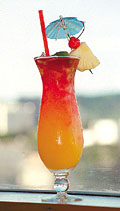By Sean Nakamura
 |
| Rum is often seen as the drink of the tropics because of its supreme mixability.
Gregory Yamamoto •The Honolulu Advertiser |
A hot sunny day basking in the penetrating rays of the sun, gawking at tanned bodies parading by. A balmy tropical night under clear moonlit skies with a limbo party beckoning "how low can you go." Fantasize about tropical locales (other than our own, of course), and undoubtedly you will imagine yourself sipping on some wildly exotic cocktail.
Mai tais, pina coladas, zombies, daiquiris and scorpions are just a few of the luscious libations that make paradise so intoxicating . . . literally. Not surprisingly, all of these concoctions owe their infamous "blind side" punch to rum.
Rum, the spirit of the tropics, is a distilled liquor made from the fermented byproducts of cane sugar production. Using the wastes of sugar production - molasses and cane sap - producers ferment the last remnants of sugar from these byproducts in order to produce alcohol.
Rum, the word is derived from "rumbullion," a West Indies term for raucous drunken behavior, may be one of the first distilled spirits created by man. Ever since the introduction of sugar cane by Christopher Columbus in the 15th century, the sugar industry and the offshoot rum industry have grown together in the many islands of the Caribbean.
While there is no international governing body regulating the production of rum, the drink can be classified into two distinct types. White or silver rums are clear, dry and light-tasting. Dark, amber or gold rums have light to deep caramel color and a deeper and richer molasses character.
Rums are produced all over the world. Wherever there is cane sugar production, it is likely you will find some sort of rum production. However, the best rums still come from the Caribbean, with different islands known for a particular characteristic style.
Let’s take a short cruise around the Caribbean to see some of these differences.
Puerto Rico
Puerto Rico has become known as one of the largest producers of rum. Much of this credit must be given to the Bacardi label, which has become the industry giant. Again, while there is no regulatory body to determine what style of rum each distillery produces, Puerto Rican rums tend to be greatly influenced by the Bacardi label.
Silver rums are produced in a lighter, drier style, but still undergo at least one year of oak aging. The decidedly neutral character of this product lends itself to mixes and exotic cocktails. Puerto Rican amber or gold rums go through additional oak aging (at least three years) and caramel coloring for flavor and, more importantly, uniform color.
Port of Call: Jamaica
Although silver rums are produced, dark rums are what Jamaica is known for. Deeply colored and pungent with molasses flavor and color, Jamaican rums are ideal for cocktails highlighting the character of the spirit. The distinctive qualities can be attributed in part to a more lengthy production process involving the use of natural yeast and remnants of previous fermentations. Deep caramel coloring to match the intensity of the molasses character of the rum completes the package. Myers, Appleton and Coruba are among the Jamaican producers making rum in this style.
Next Destination: Barbados
The island nation is home to Mount Gay Eclipse Rum, arguably the oldest rum producer, with a history dating back nearly 300 years. Darker than most Puerto Rican rums, yet more subtle than the rich Jamaican dark rums, the Mount Gay label is thought of very highly in rum-drinking circles.
Last Stop: Guyana
Guyana, on the Caribbean coast of South America, is the home of some distinctive rums. Along the Demerara River, rums are produced with intensely deep color, often darker than most Jamaican rums. Although rich in color, these rums are less pungent than their Jamaican counterparts. Demeraran rums have become known for the double-strength, 151 proof versions typically used to top high-octane cocktails. Lemon Hart is a top producer of Demeraran rums.
Rums are produced in many other locales, including Cuba, Haiti, the Dominican Republic, Bermuda, Mexico and Martinique, as well as the United States and the Philippines, although obviously not all of these will be available for sale in the United States. So-called Hawaiian rums like Hana Bay by Hawaiian Distilled Products Co. and Kahana Bay by Trader Vics are actually produced on the Mainland.
Many different styles abound, but all share the supreme mixability that makes rum the drink of the tropics.
In recent years, with interest growing in specialty and premium products, flavored rums and ultra-premium sipping rums with lengthy oak aging have been hitting the market with much success. Think of the sun and surf while enjoying your next rum concoction, whether straight or in a favorite cocktail, wherever you may be.
Concoction to try
Polynesian Paralysis is a concoction of four different rums and fruit juices - the perfect cocktail for tropical lounging. It is best served in a large, very tall glass for a dramatic layered appearance and drunk without mixing to enjoy each rum and juice combination separately.
Polynesian Paralysis
- 1 tablespoon Malibu Coconut Rum
- 1 tablespoon Captain Morgan Spiced Rum
- 1 tablespoon Bacardi Light Rum
- 1 tablespoon Myers Dark Rum
- 2-4 tablespoons pineapple juice
- 2-4 tablespoons passion fruit juice
- 2-4 tablespoons guava juice
Fill a large hurricane glass with ice, then layer rum and juice in this order, without mixing: Malibu Coconut Rum, pineapple juice, Captain Morgan Spiced Rum, passion fruit juice, Bacardi Light Rum and guava juice. Float Myers’ Dark Rum on top. Serve with a long straw for easy sipping and garnish with everything tropical such as pineapple wedge with cherry, lime wedge, flowers, umbrella and mint.
[back to top] |

 The Great Index to Fun
The Great Index to Fun